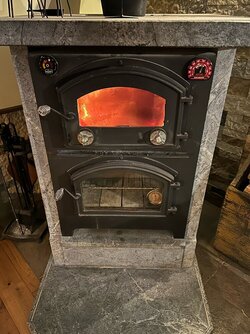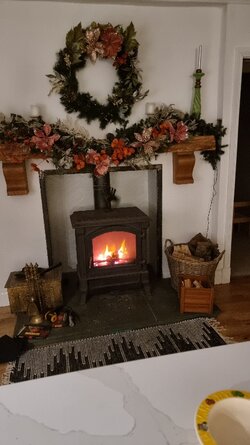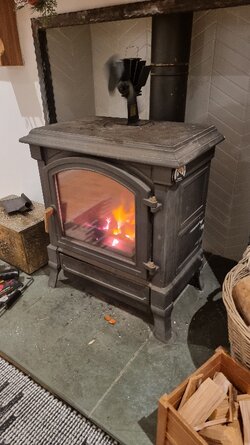Greetings, all! I have similar questions about "ideal temps" and this thread has been helpful, but I also wonder if it might vary by individual stove or not. So just curious your thoughts on the topic. My apologies in advance, but I want to provide a detailed description of our stove and the background for why I'm asking.
We purchased our home 4 years ago and it already had installed in it a Grand Wood Cook Stove (
link here, or photo is attached). This is a non-powered unit (no electric controls or dampers, no fans, etc). Very basic in design. Firebox is the top half with the two air inlets you see on the door - just manually turn open or shut. Handle on top of the stove opens/closes the damper (I'm calling it a damper, but might not be the correct term). It is either all open or all closed. When open, the exhaust goes straight up the flue. When closed, it forces the exhaust into openings located along the top of the sidewalls at the back of the firebox. Between the firebox sidewall and the outside of the stove is a "void" of a couple inches where the air circulates down the side of the unit, into the bottom of the unit (under the bottom box you see, which is an oven), and up the back of all of that where it then goes up the flue. I hope that description makes sense.
Furthermore, in our particular setup, the stove is enclosed within a soapstone structure built all around it. The stone is about 3 inches thick, and as you might assume, absorbs the heat and then radiates it for a longer period of time than what the stove might otherwise do if it were left exposed. Of note, this soapstone enclosure we believe (but do not know for certain) was constructed by the prior homeowner, not necessarily something offered by the stove manufacturer or retailer.
Every season, we've learned more as we adjust how much wood we load and how open or closed we run the air inlets. But we've yet to make it through a full season without creosote buildup at the top of the flue...thick enough we have to stop burning and do a mid-season clean. Good news is it isn't the sticky tar consistency, but rather dry and brittle. But nonetheless, enough builds up that it doesn't exhaust well enough to keep burning and when it gets windy outside, gets a reverse draft to where it "burps" smoke out of the air inlets and into the house.
The flue has a 45 degree bend just a few inches above the top of the stove, then another 45 about 12 inches later where it then goes straight up to the top of the chimney. There is approximately 6 feet of flue pipe exposed in the house (before it passes into the ceiling), and then is approximately 15-18 feet from ceiling to top of chimney. The chimney is framed/siding (not masonry or stone). Flue inside the house is double-wall and then from ceiling to top of chimney is the insulated pipe (which we had replaced new after we bought the home).
Wood we burn is mostly ash, which we cut, split, and stack ourselves. You might argue it is too seasoned, as we have a 2-year supply ready and what we're now cutting and stacking will be for the 2026-2027 season. My point is it is plenty dry - no green wood! And if it matters, when we stack it, is done so within a variety of woodsheds so it has roof covering over it all as well.
So we're trying to figure out how to get through a season without needing to stop to clean. We have a professional clean and inspection prior to each season's start, so we're starting fresh. It just seems as if we have to be doing something wrong to not be able to make it through an entire season.
I've heard it explained as an old carburetor - there are 2 variables in the equation....fuel and air. For creosote to build, you are running too rich - either too much fuel or not enough air (or both). I've read plenty about burning smaller hotter fires. But I also have read in plenty of these forums about folks who set their fire at bedtime and it lasts all night long. Maybe that is a difference in individual stoves and their load capacities, but we've never gotten anywhere near that. When we thought we were burning well and had the air inlets cranked closed a bit, we'd get a good solid 4 to 5 hour burn. Waiting much longer than 5 hours required a fair amount of bellows work to get the coals to light the next load (couldn't just place the wood in and expect it to take off on its own). However, at that air setting, we were experiencing the buildup described above.
So this year, we started burning a bit in late October or early November, but as the weather transitioned, it was on again off again based on temps. We didn't get into a constant round-the-clock-all-week burn until mid-November. Wouldn't you know it, by mid-December we already had the buildup to the point of needing to stop and clean. So since then, we've been burning with the air inlets wide-open. It is resulting in a noticeably hotter fire, to the point I wonder if it might be too hot. No signs of creosote buildup yet, although out of precaution and curiosity, in a few days I'm going to let it go out and then climb up to check the top of the chimney and see how things look. Oh, but the downside to this is requiring reload about every 3 hours. That doesn't make for a good restful night's sleep!
So all of that to lead to the eventual question - is there an "ideal" temperature on the surface of the stove to know we're doing things "right?"
As you'll see in the pic, I have two of the magnetic thermometers on the front of the unit. I know, those aren't the most accurate and I also know the temperature of the steel can vary greatly in just an inch or so. But I see on those the "overfire" zone and to stay below that results in the creosote buildup. With the air inlets wide open to where I feel things are burning cleaner, they can get to near 600 degrees. And that is on the front of the unit. The top where the flames actually hit is hard saying since it is under the soapstone. But the portion exposed right around the flue pipe connection exceeds 615 (as that is the limit on my IR gun). I wonder if I'm putting too much stock into what zones are listed on these magnetic things and just need to remove them to remove that visual/mental "limit" I'm aiming for.
The flue pipe itself will read around 400 right at the connection to the stove, 285 by the 2nd 45 bend where it then heads straight up, and just under 200 where it enters the connection box at the ceiling.
Lastly, I've checked the manual to see what it says about target/ideal temperatures. The manual is very basic, and you can
read it here if you are curious. But basically the only thing it says about burning temperatures is "do not overfire. If it glows, you have overfired." Pretty helpful, huh?! I've never gotten it that hot, so from that piece of instruction, I'm "safe." But I have a hard time just following instruction so basic as "make sure it doesn't glow and you'll be fine."
All temps above are Fahrenheit, and I hope I've given enough information to offer good advice from this group. I've only posted a few times, but have enjoyed lots of reading and appreciate all I've learned from this group. In the end, I'm just looking for that sweet spot of a hot enough burn to avoid the creosote buildup, but maximizing the length of time for the burn. It sure would be nice to sleep through the night, or even only have to get up once for any reloads.
Thanks in advance!





